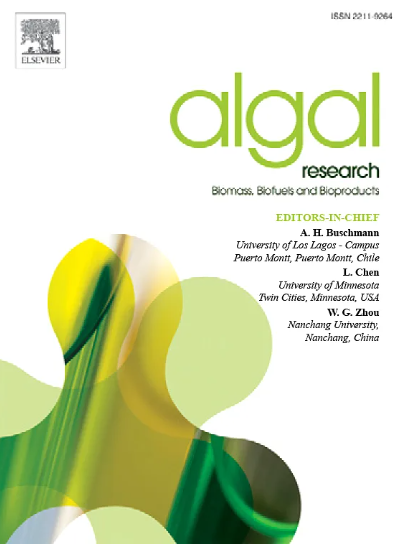辐射褐藻配子体培养和播种方法的优化
IF 4.5
2区 生物学
Q1 BIOTECHNOLOGY & APPLIED MICROBIOLOGY
Algal Research-Biomass Biofuels and Bioproducts
Pub Date : 2025-07-25
DOI:10.1016/j.algal.2025.104240
引用次数: 0
摘要
确定最佳配子体培养和播种方法是发展海带养殖新目标物种的必要条件。研究了光色(红色、白色)、光强(5 ~ 60 μmol光子m−2 s−1)和初始配子体密度(0.005 ~ 0.25 g DW L−1)对辐射Ecklonia辐射Ecklonia辐射的配子体生长和繁殖成功的影响;在3个室内试验中,研究了播种密度(0.025 ~ 0.090 mg DW m−1麻绳)、生物量状态(营养配子体、微观孢子体)和播种方式(喷雾、喷雾+摩擦、黄原胶结合剂、海藻酸盐结合剂)对孢子体密度、生长和附着强度的影响。我们发现,在不同的光色、光强和放养密度下,放养的放养体的生长和繁殖成功率存在显著差异。不同的播种方式、不同的播种密度和不同的生物量状态对麻绳孵化场的孢子体密度、生长和附着强度也有显著的影响。根据我们的研究结果,我们建议将配子体培养物置于20 μmol光子m−2 s−1的红光下,密度为0.025 g DW L−1,以最大限度地提高营养生长,而将培养物置于20 μmol光子m−2 s−1的白光下,密度为0.005-0.05 g DW L−1,可以在两周内诱导成功繁殖。对于孵化场播种和栽培,我们建议将营养配子体生物量以0.090 mg DW m - 1麻线的密度喷洒在播种线上。在播种前使用黏合剂或诱导生物量繁殖均无优势。本文章由计算机程序翻译,如有差异,请以英文原文为准。
Optimisation of gametophyte culturing and seeding methods for cultivation of the kelp Ecklonia radiata
Identification of optimal gametophyte culturing and seeding methods is essential for the development of kelp aquaculture for novel target species. We investigated the effects of light colour (red, white), light intensity (5–60 μmol photons m−2 s−1) and initial gametophyte density (0.005–0.25 g DW L−1) on gametophyte growth and reproductive success in Ecklonia radiata; and the effects of seeding density (0.025–0.090 mg DW m−1 twine), biomass state (vegetative gametophyte, microscopic sporophyte), and seeding method (spray, spray+rub, xanthan binder, alginate binder) on sporophyte density, growth and attachment strength on seeding twine in three laboratory experiments. We found pronounced and significant differences in the growth and reproductive success of E. radiata gametophytes in free floating cultures maintained under different light colours, light intensities and stocking densities. We also found substantial and significant differences in sporophyte density, growth and attachment strength among seeding methods, seeding densities and biomass states for hatchery seeding of twine. Based on our results we recommend maintaining gametophyte cultures under red light at an intensity of 20 μmol photons m−2 s−1 and a density of 0.025 g DW L−1 to maximise vegetative growth, while successful reproduction can be induced within two weeks by placing cultures under white light at 20 μmol photons m−2 s−1 and a density of 0.005–0.05 g DW L−1. For hatchery seeding and cultivation, we recommend spraying vegetative gametophyte biomass onto seeding twine at a density of 0.090 mg DW m−1 twine. There was no advantage to using binders or inducing reproduction in biomass prior to seeding.
求助全文
通过发布文献求助,成功后即可免费获取论文全文。
去求助
来源期刊

Algal Research-Biomass Biofuels and Bioproducts
BIOTECHNOLOGY & APPLIED MICROBIOLOGY-
CiteScore
9.40
自引率
7.80%
发文量
332
期刊介绍:
Algal Research is an international phycology journal covering all areas of emerging technologies in algae biology, biomass production, cultivation, harvesting, extraction, bioproducts, biorefinery, engineering, and econometrics. Algae is defined to include cyanobacteria, microalgae, and protists and symbionts of interest in biotechnology. The journal publishes original research and reviews for the following scope: algal biology, including but not exclusive to: phylogeny, biodiversity, molecular traits, metabolic regulation, and genetic engineering, algal cultivation, e.g. phototrophic systems, heterotrophic systems, and mixotrophic systems, algal harvesting and extraction systems, biotechnology to convert algal biomass and components into biofuels and bioproducts, e.g., nutraceuticals, pharmaceuticals, animal feed, plastics, etc. algal products and their economic assessment
 求助内容:
求助内容: 应助结果提醒方式:
应助结果提醒方式:


